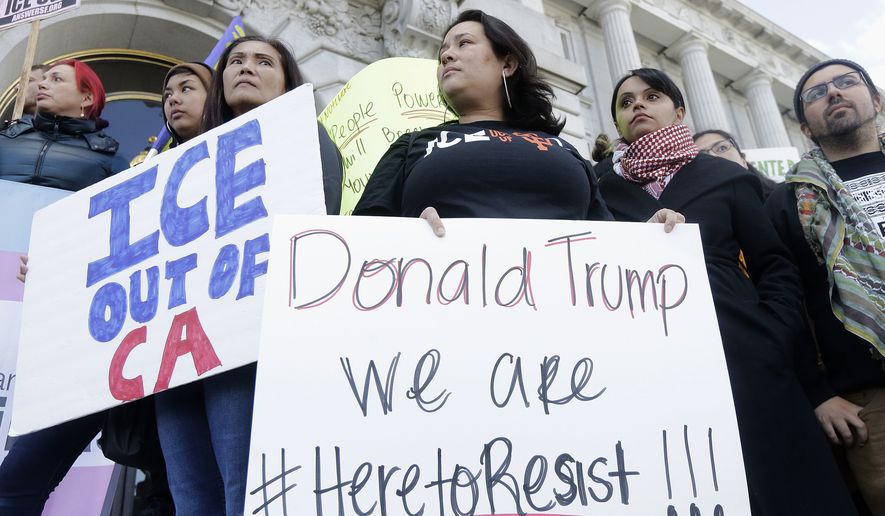Sanctuary cities are actually enticing more people to pay smugglers to help them make the dangerous trek north, not only putting people at risk but also enriching the smuggling cartels themselves, a senior administration official said Monday.
The senior official also gave sanctuary cities a choice: either allow his deportation officers in their jails to arrest illegal immigrants, or else he’ll have to send the officers out into the streets to get people in the communities.
“The more people I have in the jail the less people I have to send out on the street to look for them,” the official said, speaking on condition he not be named as part of a background briefing set up by the White House ahead of President Trump’s trip to California Tuesday.
The White House did authorize Thomas Homan, deputy director of U.S. Immigration and Customs Enforcement, to speak on the record, and he said he’s seen police and sheriff’s departments pull out of anti-drug and anti-smuggling task forces because of the sanctuary laws.
“Local law enforcement had to leave these task forces because they weren’t allowed to work on them,” he said.
Officials billed the call as a chance to answer what they said were misconceptions about sanctuary city policies, particularly in California. That state last year enacted three laws that prevent local law enforcement from asking people their immigration status and from holding migrants for pickup by ICE, and limits how much information they’re allowed to provide to ICE officers; orders businesses to refuse voluntary cooperation with ICE; and orders state investigators to probe the federal government’s handling of immigrants held in detention facilities in the state.
The Justice Department last week sued to block those three laws, prompting an outraged response from Democrats who control the state’s government.
“This is basically going to war against the state of California,” Gov. Jerry Brown said.
He bristled at accusations that federal officers were being blocked from access to local jails.
“That’s not true. We know the Trump administration is full of liars,” he said.
Mr. Homan, though, said the state’s own sheriff’s association has said it cannot fully cooperate with federal authorities under the outlines of Mr. Brown’s law.
Mr. Homan also blasted U.S. House Minority Leader Nancy Pelosi, who called ICE enforcement actions last month “unjust and cruel.”
Mrs. Pelosi and other anti-Trump politicians have urged ICE to focus on illegal immigrants with what they deem serious crimes on their records, and forgo deporting most illegal immigrants.
Mr. Homan countered that Mrs. Pelosi and others in Congress can change the laws, but for now, the laws give his agents and officers the duty of arresting people in the country illegally and putting them through the immigration courts, where they are ordered deported — orders his agency then must carry out.
The senior administration official gave a detailed list of ills he said stemmed from California’s sanctuary laws, saying the cartels that control all of the human smuggling across the U.S.-Mexico border are using sanctuaries as “a selling point” to would-be illegal immigrants.
“This sort of carrot-dangling … is going to entice more illegal immigrants,” the official said, adding that means more money going to the same cartels that also could smuggle in weapons, drugs and even terrorists.
“We’re bankrolling them with these sanctuary policies,” the official said.
When ICE is seeking an illegal immigrant target and knows the person has been booked into a local prison or jail it will send a detainer request both asking to be notified before the person is released, and for the person to be held for up to 48 hours after the normal release point for pickup.
The senior official said ICE has concluded both requests are legal, but he would be satisfied if local law enforcement at least gave the heads-up before release, giving his officers a chance to collect targets before they’re released into the community.
He said one officer operating in a jail can process 10 illegal immigrants in a day, but if those 10 are all released it takes six-man teams days, weeks or even months to track them down out in the community, where everyone is at more risk.
• Stephen Dinan can be reached at sdinan@washingtontimes.com.




Please read our comment policy before commenting.